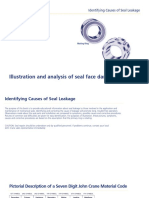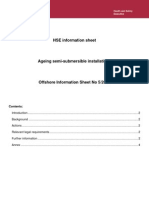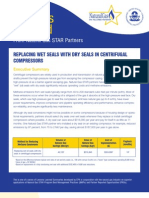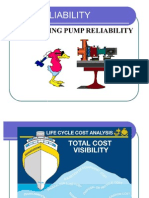Check List Compresor
Check List Compresor
Uploaded by
Yoaida Marte CanelaCopyright:
Available Formats
Check List Compresor
Check List Compresor
Uploaded by
Yoaida Marte CanelaCopyright
Available Formats
Share this document
Did you find this document useful?
Is this content inappropriate?
Copyright:
Available Formats
Check List Compresor
Check List Compresor
Uploaded by
Yoaida Marte CanelaCopyright:
Available Formats
START UP CHECK LIST RECIPROCATING COMPRESSORS
Compressor Model ___________________ Serial/No. F-_______________
Cylinder S/N C-______ C-______ C-______ C-______ C-______ C-______ Driver ___________________________________ Rated Speed_________________ Packager ________________________________ Date Packager Shipped _____________________ Serviceman ______________________________ Location _________________________________ Field Telephone No. ________________________ Frame Oil - Make/Grade ____________________ Cylinder Oil - Make/Grade ___________________ Packager Unit No.______________ Start Up Date _________________ Customer ____________________ Field Contact _________________ Unit Location __________________ _____________________________ _____________________________
Compressor Model ___________________ Serial/No. F-_______________ YES Check List - Prior To Starting:
1. Are the correct Ariel parts book, technical manual, special tools, and spares available? 2. Have the design limitations for the compressor model such as rod load, maximum and minimum speed, discharge temperature been checked? 3. Have the design operating conditions been determined? Pressure, psig (barg): Suction ________ Discharge________ Temperature, F (C): Suction ________ Discharge________ Maximum RPM __________ Minimum RPM __________ 4. Soft Foot Check & Frame Flatness: Have the compressor feet and crosshead guide supports been shimmed so the machine is not twisted or bent, and frame flatness for JGU:Z/4 & larger been checked (Ref ER-82)? More than 0.002 inches (0.05 mm) soft foot pull-down requires correction. Record compressor feet pull-down readings: _______ _______ _______ _______ Drive-End _______ _______ _______ _______
__________ __________
NO
__________ __________
__________ __________
__________
__________
9
REV
P1, at 4 added frame flatness requirements. P2 at 7 & P6 at 16 revd to allow greater TIR for larger couplings. P5, at 7, clarified high discharge gas temperature shutdown settings.
7 6 5 4 3
12515 011766 8236 6887 6633 EC
11-22-04 2-6-04 ------DATE 9 8 REV 014565 012216 EC 11-19-07 7-12-06 DATE
DESCRIPTION
REV
PAGE 1 OF 6
ER-10.4.0
The contents of this document are proprietary and confidential. They are the property of Ariel Corporation and may not be disclosed, reproduced, or used for manufacture in part or in whole without written permission from Ariel Corporation.
START UP CHECK LIST RECIPROCATING COMPRESSORS
Compressor Model ___________________ Serial/No. F-_______________ YES NO
5. Have crosshead feeler gage clearances been checked with cyl__________ __________ inders mounted? Top is checked by inserting 0.5 inch (12.7 mm) wide feelers from one side edge across to the opposite side, at both ends. See Technical Manual, Section 1, Clearances for limits. Bottom is checked with a 0.0015 inches (0.038 mm) feeler at the (4) corners. Feeler insertion is 0.50 inches (13 mm) maximum at each corner. Record feeler values below: Throw Record Crosshead to Guide Feeler Gage Clearances Number Top minimum Top maximum Bottom max. Corner Insertion ________ ________ ________ 1 ________ ________ ________ 2 ________ ________ ________ 3 ________ ________ ________ 4 ________ ________ ________ 5 ________ ________ ________ 6 6. Have the piping and supports been checked to be sure they do not bend or stress compressor?
__________ __________
7. Has the compressor to driver alignment been checked at site? Maximum allowable 0.005 inches (0.13 mm) TIR on coupling hub __________ face and rim, except for hub O.D. >17 in. (.>43 cm) angular face limit is 0 1 (0.0167)1. Take thermal growth into account. 8. Have coupling face dial indicator readings been taken? Record __________ in inches (mm) at the 3, 6, 9 and 12 oclock positions on lines provided below:
__________
__________
Face
Rim
9. Has the compressor crankshaft thrust clearance been checked? See Technical Manual, Section 1, Clearances. Record compressor crankshaft thrust clearance here: inches (mm) 10. Have piston end clearances been checked with feeler gages2? See Technical Manual, Section 1, Clearances. Record below: Throw No. PAGE 2 OF 6
1 2 3 4
__________
__________
__________ 5
__________ 6
REV 9
ER-10.4.0
The contents of this document are proprietary and confidential. They are the property of Ariel Corporation and may not be disclosed, reproduced, or used for manufacture in part or in whole without written permission from Ariel Corporation.
START UP CHECK LIST RECIPROCATING COMPRESSORS
Compressor Model ___________________ Serial/No. F-_______________ YES
Head End _______ _______ _______ _______ Crank End _______ _______ _______ _______ 11. Has piston rod runout been checked? See Technical Manual, Section 5 for maximum acceptable readings. Record Below: Throw No.
1 2 3 4
NO
_______ _______
__________ 6
The contents of this document are proprietary and confidential. They are the property of Ariel Corporation and may not be disclosed, reproduced, or used for manufacture in part or in whole without written permission from Ariel Corporation.
_______ _______
__________ 5
Vertical: Piston @ CE _______ _______ _______ _______ Mid-Stroke _______ _______ _______ _______ Piston @ HE _______ _______ _______ _______ Horizontal: Piston @ CE _______ _______ _______ _______ Mid-Stroke _______ _______ _______ _______ Piston @ HE _______ _______ _______ _______ 12. Has the compressor crankcase been filled with oil to the proper level? Approximately 7/8 full in site glass, prior to starting. 13. Has proper oil been installed if extreme ambient conditions exist or special gases are compressed? 14. Is the compressor crankcase oil level control working and set at the proper level and properly vented? 15. Is the crankcase oil supply isolation valve open? 16. Does the crankcase low level shutdown work? 17. Has the recommended oil filter element been installed? 18. Are the oil filter element and all lube oil piping primed with oil? 19. Is the low oil pressure shutdown installed and tubed correctly to the downstream side of the oil filter? 20. Does the low oil pressure shutdown work? 21. Oil cooler? Compressor inlet oil temp. is 190F (88C) maximum. 22. Is the crankcase oil temperature shutdown installed, set and working? 23. If oil is cooled, is there a temperature control valve? 24. Is the crankcase breather element clean? 25. Is the force feed lubricator box filled with oil? 26. Is the force feed lubrication system primed? PAGE 3 OF 6 REV 9
_______ _______ _______ _______ _______ _______
__________ __________ __________ __________ __________ __________ __________ __________ __________ __________
_______ _______ _______ _______ _______ _______
__________ __________ __________ __________ __________ __________ __________ __________ __________ __________
__________ __________ __________ __________ __________
__________ __________ __________ __________ __________
ER-10.4.0
START UP CHECK LIST RECIPROCATING COMPRESSORS
Compressor Model ___________________ Serial/No. F-_______________ YES
27. Is the force feed lubrication system no flow shutdown installed and working? 28. Is the force feed blow out assembly installed? Check rupture disc for color? See Lubrication section of the Technical Manual for disc color vs. rating table. 29. Has the lubricator instruction plate or Parts Book Cylinder Lubrication Sheet been checked for proper lube feed rate? 30. Is there a working vibration shutdown mounted on the compressor and adjusted properly? 31. Are the primary and secondary packing-case, and the crosshead-distance-piece vents and drains open, and when necessary, tubed off of the skid or out of the building? 32. Is there some method of suction pressure control? 33. Are the suction pressure, inter-stage pressure and discharge pressure shutdowns set and working? 34. Are the safety relief valves installed and working to protect cylinders and piping for each stage of compression? 35. Are the gas discharge temperature shutdowns installed, set and working? 36. Have the gas suction lines been blown out to remove water, slag, dirt, etc.? 37. Have temporary screens been installed at cylinder suction? 38. Has compressor been prelubed prior to starting? If motor driven, unattended or large frame models prelube at 10 psig (0.7 barg) & 30 seconds minimum? 39. For engine driven units, has the machine been rolled with the starter to make sure it is free? The oil pressure should come up noticeably while rolling on the starter. 40. For other drivers, has the machine been barred over by hand to ensure it is rolling free? 41.Does the driver rotation match the compressor rotation arrow? 42.Have torque values been checked on all critical fasteners where loosening could result in a safety hazard or equipment failure, and including: gas nozzle flange, valve cap, cylinder head, compressor rod packing, hold down, crosshead guide support and coupling bolting?
__________
NO
__________
The contents of this document are proprietary and confidential. They are the property of Ariel Corporation and may not be disclosed, reproduced, or used for manufacture in part or in whole without written permission from Ariel Corporation.
__________ __________ __________
__________ __________ __________
__________ __________ __________ __________ __________ __________ __________
__________ __________ __________ __________ __________ __________ __________
__________
__________
__________ __________ __________
__________ __________ __________
__________
__________
PAGE 4 OF 6
REV 9
ER-10.4.0
START UP CHECK LIST RECIPROCATING COMPRESSORS
Compressor Model ___________________ Serial/No. F-_______________ YES
43. For machines compressing a combustible gas, have the piping and compressor been purged to remove all air? 44. Have start-up instructions for other package equipment been followed? 45. Is the compressor skid properly grounded to a suitable earth ground? 46.Has the Packagers representative done the required review of the Packagers Start-Up and Operating Instructions for the unit with the unit operator?
__________ __________ __________
NO
__________ __________ __________
The contents of this document are proprietary and confidential. They are the property of Ariel Corporation and may not be disclosed, reproduced, or used for manufacture in part or in whole without written permission from Ariel Corporation.
__________
__________
Check List - After Starting:
1. Did the oil pressure come up immediately? 2. Are the oil filter pressure gauges working? 3. Is oil filter differential pressure less than filter change value? Reference value listed on filter information plate on compressor top cover. 4. Any strange noises or shaking in the compressor or piping? 5. Is low oil pressure shutdown set at 35 psig (2.4 barg)? 6. Is oil pressure set at 50 to 60 psig (3.5 to 4.2 bar) at operating speed and temperature? Reference Technical Manual, Section 4. 7. Are the high discharge gas temperature shutdowns set within 10% or as close as practical above normal discharge temperature & not exceeding the maximum discharge temperature shutdown setting for the service in which compressor is operating? 8. Is the distribution block indicator working and lubricator set for proper break-in flow rate? 9. Are there any oil leaks? If so, where? 10. Are the scrubber dumps and high level shutdowns working? 11. Are the scrubbers removing all liquids from the gas? How often do they dump? (_____minutes) 12. Are there sands or oxides in the gas? 13. Is the overspeed shutdown set? 14. Are rod packings sealing properly? 15. Have all safety functions been tested to ensure shutdown of unit upon malfunction?
__________ __________ __________ __________
__________ __________ __________ __________
__________ __________ __________ __________
__________
__________
__________ __________ __________ __________ __________ __________ __________ __________
__________ __________ __________ __________ __________ __________ __________ __________
PAGE 5 OF 6
REV 9
ER-10.4.0
START UP CHECK LIST RECIPROCATING COMPRESSORS
Compressor Model ___________________ Serial/No. F-_______________ YES
16. Have coupling dial indicator readings1 been taken and within allowable limits, after reaching normal operating temperatures and components become heat soaked? Shutdown, vent gas system3 and record dial indicator readings, in the hot condition within 30 minutes, in inches (mm) at the 3, 6, 9 and 12 oclock face positions on lines provided below:
NO
__________
__________
Face
Rim
17. If discharge bottle or head end cylinder supports are used, have they been adjusted when components are heat soaked to ensure there are no excessive forces that would cause detrimental __________ __________ cylinder deflection? 18. Has fastener torque on gas nozzle flange, valve cap, cylinder __________ __________ head and compressor rod packing flange bolting been rechecked2 when components are heat soaked? 19. Complete Ariels Compressor Warranty Notification and Installation List Data, copy this completed Start-up Checklist and mail both to Ariel Corporation, 35 Blackjack Road, Mount Vernon, OH 43050, USA, Attention: Administrative Assistant - Sales or fax to Ariel at 740397-3856, Attention: Administrative Assistant - Sales. Footnotes 1. Maximum allowable 0.005 inches (0.13 mm) TIR on coupling hub face and rim, except for larger hub O.D. angular face TIR limit: >17 in. x 0.00029 = TIR max., in. (>43 cm x 0.0029 = TIR max., mm). 2. Piston end clearances need not be checked on cylinders where the compressor was tested mechanically complete at the Ariel factory (compressor has an inspection tag) and the crosshead-balance nuts have not been loosened since shipment from Ariel. 3. CAUTION! BE SURE THAT THE COMPRESSOR IS COMPLETELY VENTED TO RELIEVE ALL GAS PRESSURE, AND THE DRIVER WILL NOT EXERT TORQUE ON THE COMPRESSOR CRANKSHAFT THAT COULD RESULT IN INJURY, PRIOR TO TAKING COUPLING READINGS, RE-CHECKING BOLTING TORQUES ON PRESSURE CONTAINING COMPONENTS OR REMOVING ACCESS COVERS FOR PERFORMING INTERNAL INSPECTION OR MAINTENANCE ON THE COMPRESSOR. IN THE CASE OF A DIRECT DRIVE MOTOR, THE BREAKER IS LOCKED OUT. FAILURE TO FOLLOW THESE STEPS CAN RESULT IN SERIOUS PERSONAL INJURY OR DEATH. PAGE 6 OF 6 REV 9 ER-10.4.0
The contents of this document are proprietary and confidential. They are the property of Ariel Corporation and may not be disclosed, reproduced, or used for manufacture in part or in whole without written permission from Ariel Corporation.
You might also like
- Shaft Coupling and AlignmentDocument17 pagesShaft Coupling and AlignmentKiddos GardenerNo ratings yet
- RCA - Mechanical - Seal - 1684971197 2Document20 pagesRCA - Mechanical - Seal - 1684971197 2HungphamphiNo ratings yet
- Ex09 2 SolDocument9 pagesEx09 2 SolToonz NetworkNo ratings yet
- Advanced Cylinder Configuration: Options TabDocument4 pagesAdvanced Cylinder Configuration: Options TabJose RattiaNo ratings yet
- Navalny Final Intervention 14.01.2020 No CoverDocument16 pagesNavalny Final Intervention 14.01.2020 No CoverEuropean Human Rights Advocacy Centre (EHRAC)No ratings yet
- Reciprocating Multiruns: Case Packages Multirun InteractionDocument6 pagesReciprocating Multiruns: Case Packages Multirun InteractionJose RattiaNo ratings yet
- HSE Information Sheet Ageing Semi-Submersible Installations Offshore Information Sheet No 5 2007Document5 pagesHSE Information Sheet Ageing Semi-Submersible Installations Offshore Information Sheet No 5 2007Saeed JabbariNo ratings yet
- R3215-005041 Appendix A 2.0 - Datasheet For Corrosion CouponDocument1 pageR3215-005041 Appendix A 2.0 - Datasheet For Corrosion Couponsaiful anwarNo ratings yet
- Lastec 421d PartsDocument145 pagesLastec 421d PartsCharles WernerNo ratings yet
- AT6356E microIFEM Piezo 4P4x PDFDocument64 pagesAT6356E microIFEM Piezo 4P4x PDFmilkicas266No ratings yet
- TTI Turboexpander Description-RecDocument36 pagesTTI Turboexpander Description-Recgurguri5691100% (1)
- Start-Up Check ListDocument3 pagesStart-Up Check ListgustavoespinosamNo ratings yet
- Running Performance: Service/Stage Data Performance OutputDocument2 pagesRunning Performance: Service/Stage Data Performance OutputJose RattiaNo ratings yet
- Hydrocom: Experience Real Capacity Control and Energy SavingsDocument8 pagesHydrocom: Experience Real Capacity Control and Energy SavingsVignesh Dheenakumar100% (1)
- Er 108 1Document3 pagesEr 108 1DIEGO YECID MILLAN MENDOZANo ratings yet
- Annual Maintenance Plan and BudgetDocument3 pagesAnnual Maintenance Plan and Budgetyadira100% (1)
- Centrifugal CompressorDocument15 pagesCentrifugal CompressorSandeep ThangellapallliNo ratings yet
- Gas Turbine - Compressor AlignmentDocument2 pagesGas Turbine - Compressor AlignmentNazmiNo ratings yet
- Effective Constant Level LubricationDocument6 pagesEffective Constant Level Lubricationdaniel adamNo ratings yet
- Air Compressor Rev1Document5 pagesAir Compressor Rev1asifNo ratings yet
- Pneumatic Control SystemfinalDocument6 pagesPneumatic Control Systemfinalneo100% (1)
- Alignment of Shaft For Pump and Motor Using DTIDocument2 pagesAlignment of Shaft For Pump and Motor Using DTIRAMALINGUM BRIAN RUNGEN50% (2)
- Failure Code 2FEB2019Document30 pagesFailure Code 2FEB2019Rylai CrestfallNo ratings yet
- An End-User's Guide To Centrifugal Pump RotordynamicsDocument22 pagesAn End-User's Guide To Centrifugal Pump RotordynamicsbwelzNo ratings yet
- Operating Dry Screw CompressorsDocument3 pagesOperating Dry Screw Compressorskamal arabNo ratings yet
- Management of Change (Moc)Document6 pagesManagement of Change (Moc)kheireddine fekrouneNo ratings yet
- Procedure To Restart Critical EquipmentDocument1 pageProcedure To Restart Critical EquipmentPeter Hazops100% (2)
- A Compendium and Comparison of 25 Project Evaluation Techniques. Part 1 Net Present Value and Rate of Return MethodsDocument18 pagesA Compendium and Comparison of 25 Project Evaluation Techniques. Part 1 Net Present Value and Rate of Return MethodsRama RenspandyNo ratings yet
- Aatisbh Sehgal CV PDFDocument5 pagesAatisbh Sehgal CV PDFAnkush SehgalNo ratings yet
- SECTION 2-General Maintanance PDFDocument18 pagesSECTION 2-General Maintanance PDFDidin Delgado0% (1)
- OM Manuals TemplateDocument9 pagesOM Manuals TemplatejanempatricioNo ratings yet
- Compressor Brochure A4 - SpreadsDocument27 pagesCompressor Brochure A4 - SpreadsIwan Abdurahman100% (1)
- Sonceboz Chart Recorder Motor Spec SheetDocument2 pagesSonceboz Chart Recorder Motor Spec Sheetjesdcp7No ratings yet
- C-051-VP-040-CLTW-PRO-0007 Rev. A Pre Commissioning Commissioning ProcedureDocument11 pagesC-051-VP-040-CLTW-PRO-0007 Rev. A Pre Commissioning Commissioning ProcedureMidha NeerNo ratings yet
- Standard Operating Procedure-Standard Maintenace ProcedureDocument11 pagesStandard Operating Procedure-Standard Maintenace ProcedureVikram JitNo ratings yet
- Offshore Technicians Recruitment Programme 2001: Operations Technician Interview QuestionsDocument15 pagesOffshore Technicians Recruitment Programme 2001: Operations Technician Interview QuestionsJohnYuillNo ratings yet
- Specialist Services: Preventive Maintenance ChecklistDocument2 pagesSpecialist Services: Preventive Maintenance ChecklistNakkolopNo ratings yet
- ES9-414 Leveling Install - CDocument29 pagesES9-414 Leveling Install - CIfran Sierra100% (1)
- ChecklistDocument2 pagesChecklistdassayevNo ratings yet
- Spares ManagementDocument64 pagesSpares ManagementConrad RodricksNo ratings yet
- Compressor For OILDocument74 pagesCompressor For OILRana BiswasNo ratings yet
- API RP 687-2001 (2015) Ut BabbitpdfDocument1 pageAPI RP 687-2001 (2015) Ut BabbitpdfudomNo ratings yet
- Shop Test Procedure For TurbineDocument9 pagesShop Test Procedure For TurbineAbdulNo ratings yet
- Centrifugal PumpDocument31 pagesCentrifugal PumpGilang AdityaNo ratings yet
- Dresser-Rand Start Up F324GSIDocument5 pagesDresser-Rand Start Up F324GSIMuhammadShadabNo ratings yet
- Lessons LearnedDocument13 pagesLessons LearnedBilaljafraniNo ratings yet
- Reciprocating Compressor MaintenanceDocument5 pagesReciprocating Compressor MaintenanceshimaNo ratings yet
- Curriculum Vitae: S.Bebin RoyDocument3 pagesCurriculum Vitae: S.Bebin RoyDIJUNo ratings yet
- Pump ReliabilityDocument63 pagesPump Reliabilityzaksonu91221100% (1)
- D VipDocument6 pagesD VipClemente Rafael Marval EscalonaNo ratings yet
- Procedures For Lube Oil CommissioningDocument3 pagesProcedures For Lube Oil Commissioningavciay100% (1)
- CMMS StrategyDocument12 pagesCMMS StrategyDia Putranto HarmayNo ratings yet
- Start-Up and Operations Report PDFDocument3 pagesStart-Up and Operations Report PDFdennis_ugarte100% (1)
- 18 83585 Control Philosophy - G01-E002453-01-001Document19 pages18 83585 Control Philosophy - G01-E002453-01-001manuNo ratings yet
- Automation of Reciprocating Gas Engine Compressor Packages UsingDocument7 pagesAutomation of Reciprocating Gas Engine Compressor Packages UsingGnanaSekar0% (1)
- Standard Operating Procedures For FS EquipmentsDocument24 pagesStandard Operating Procedures For FS EquipmentsAnonymous LFgO4WbIDNo ratings yet
- Anilkumar Kanjibhai Patel (Mechanical Technician) Updated CVDocument5 pagesAnilkumar Kanjibhai Patel (Mechanical Technician) Updated CVpavitravpatelNo ratings yet
- STG Lube Oil FlushingDocument58 pagesSTG Lube Oil FlushingAnthony DelarosaNo ratings yet
- Balance DrumDocument2 pagesBalance Drumpsshnkr100% (1)
- Sihi 105Document8 pagesSihi 105Sandi AslanNo ratings yet
- lean spare parts management A Complete Guide - 2019 EditionFrom Everandlean spare parts management A Complete Guide - 2019 EditionNo ratings yet
- CMMS computerized maintenance management system The Ultimate Step-By-Step GuideFrom EverandCMMS computerized maintenance management system The Ultimate Step-By-Step GuideNo ratings yet
- No Contact RuleDocument10 pagesNo Contact RuleExBackExpertiseNo ratings yet
- Science Module 2Document9 pagesScience Module 2Prince Mhar SurioNo ratings yet
- Class 9th Cbse Subjective Pattern 15-06-2024Document5 pagesClass 9th Cbse Subjective Pattern 15-06-2024PRASHANT SHUKLANo ratings yet
- Kendalls and Marzanos New TaxonomyDocument22 pagesKendalls and Marzanos New TaxonomyRUTHY ANN BALBIN BEEd 2-1100% (2)
- DLL - Science 4 - Q2 - W5Document4 pagesDLL - Science 4 - Q2 - W5josefadrilanNo ratings yet
- Spinors and The Dirac EquationDocument19 pagesSpinors and The Dirac EquationandysitobelloNo ratings yet
- Usr Local SRC Education - Com Files Static Lesson-Plans Superhero-Citizens Superhero-CitizensDocument8 pagesUsr Local SRC Education - Com Files Static Lesson-Plans Superhero-Citizens Superhero-Citizenshannah songNo ratings yet
- Search Algorithms in Artificial IntelligenceDocument13 pagesSearch Algorithms in Artificial IntelligencenandhiniNo ratings yet
- 11-MURAT AUTOMOTIVE MITSUBISHI - 2017 - 04 PRODUCT CATALOG - Compressed PDFDocument92 pages11-MURAT AUTOMOTIVE MITSUBISHI - 2017 - 04 PRODUCT CATALOG - Compressed PDFFredy HernanNo ratings yet
- Computer Science 3A - CSC3A10/CSC03A3: Lecture 2: Arrays, Linked Lists and RecursionDocument66 pagesComputer Science 3A - CSC3A10/CSC03A3: Lecture 2: Arrays, Linked Lists and Recursionthapelo mokoloNo ratings yet
- Women Entrepreneurs - A Mirage of Indian WomenDocument1 pageWomen Entrepreneurs - A Mirage of Indian WomenRajni GargNo ratings yet
- GOLDEN DAWN 3 8 Energy Influences On The PathsDocument4 pagesGOLDEN DAWN 3 8 Energy Influences On The PathsF_RCNo ratings yet
- Current Affairs May 2023Document12 pagesCurrent Affairs May 2023gourip6559No ratings yet
- SDS Product SF 05 English VersionDocument11 pagesSDS Product SF 05 English VersionfaisalchemNo ratings yet
- TTRC Website ArticlesDocument4 pagesTTRC Website ArticlesPradeep JainNo ratings yet
- Mcqs Project MGMTDocument11 pagesMcqs Project MGMTsamNo ratings yet
- JG-CECIB-Project PlanningDocument73 pagesJG-CECIB-Project PlanningRiya GupteNo ratings yet
- Explanation of Maxon EC Motor TerminologyDocument1 pageExplanation of Maxon EC Motor TerminologyfurkanfurkanfurkanNo ratings yet
- Selling ConceptDocument6 pagesSelling ConceptDhurba Bahadur BkNo ratings yet
- TIHK Query Sheet No.139.6Document1 pageTIHK Query Sheet No.139.6asd2sas2No ratings yet
- Metro Lite SystemDocument14 pagesMetro Lite SystemAPEXA ARYANo ratings yet
- Ipaml FinalsDocument3 pagesIpaml FinalsQuenneeNo ratings yet
- Connectors 3 1 PDFDocument246 pagesConnectors 3 1 PDFZian HennNo ratings yet
- Operating Manual - ASC 150 Murphy Cummins Tier 3 - enDocument1 pageOperating Manual - ASC 150 Murphy Cummins Tier 3 - enIhorNo ratings yet
- Is A Process in Which Ethical Issues and Problems Are Benchmarked Against A MoralDocument3 pagesIs A Process in Which Ethical Issues and Problems Are Benchmarked Against A MoralGround ZeroNo ratings yet
- Third Cycle ProgramsDocument3 pagesThird Cycle Programsbeauty rajaNo ratings yet

























































































